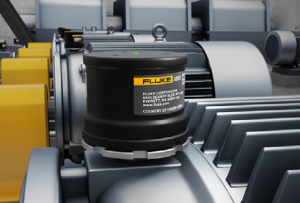
Condition monitoring can bring relief to expertise-constrained teams
By By John Bernet, Fluke Corporation
Features Fluke Reliability IIoT labour shortages maintenance mean time to repair MTTR workers There are many ways to bridge employee shortages using Industrial Internet of Things (IIoT) technology.
There are many ways to bridge employee shortages using Industrial Internet of Things (IIoT) technology. The past several years has brought massive change for manufacturing — with the COVID-19 pandemic both creating new challenges and exacerbating existing challenges. Most recently, one of the biggest challenges has been a shortage of skilled labour that has left many employers scrambling to fill open roles.
The shortage has been driven by multiple factors, including the overall job market, wage stagnation, burnout, and more. The question for organizations is not only how they can overcome hurdles and maintain business continuity in this worker’s economy, but also how they will position themselves advantageously for the future.
First, businesses need to understand why there a worker shortage.
The worker shortage first appeared in low-wage jobs like fast-food service and manual labour. These front-line workers were hit hardest by the pandemic, driving many to seek alternative career paths, including what’s become known as “gig” work, to gain more control over their health and livelihoods.
This trend spread like wildfire across almost every industry, leading to an unprecedented shakeup of the worldwide labour market. Overall, employees have become burnt out for various reasons and more apt to prioritize their health and wellness over a particular job. It’s a complex crisis, and one that’s still shifting with the evolving economic state. However, there are many ways to bridge employee shortages using Industrial Internet of Things (IIoT) technology.
1. Reduce the impact of labour shortages with connected reliability
The industrial space is feeling the impact of the labour gap. Skilled tradespeople were already in high demand before the pandemic, and that gap has only worsened as knowledge is actively walking out the doors. In addition, with fewer employees, keeping up with standard preventive maintenance tasks has become a challenge in and of itself, forcing some organizations to all but abandon their journey toward predictive maintenance. However, the connected reliability technologies that drive predictive maintenance are actually key to solving today’s labour shortage challenges.
What is connected reliability?
Connected reliability means that there is a continuous and effective stream of communication between all systems, assets, and people. It means that your critical assets are connected to the cloud via devices that collect comprehensive data on asset health, runtimes, and performance. Workers can then use that data and insight to make smart decisions and focus their maintenance efforts where they are needed most—avoiding unnecessary busy work and making the most of the resources available.
Connected reliability makes the data available and usable for your team to act on the findings in the most productive and efficient way. Connected reliability also means that workers can leverage existing data in new ways. For example, with a condition monitoring service, external experts can remotely monitor assets and identify faults prior to a failure, so your team can focus on the easy-to-resolve challenges before they turn into more complex repairs—or worse catastrophic failures. In other words, IIoT technology gives your team the ability to work smarter and more effectively, even with fewer workers available. Many IIoT technologies are also easy to use and interpret, even without extensive training and experience.
2. Leverage IIoT to effectively manage your maintenance backlog
Backlog accumulation often goes hand in hand with worker shortages. The longer work goes uncomplete, the most your maintenance backlog piles up and the higher the risk of costly failures or safety issues. Therefore, maintaining control over your backlog is critical to safe, smooth operations.
With the data from IIoT, you can more effectively track your maintenance KPIs, prioritize work orders based on criticality, and assign tasks according to the skills and experience of your current employees. Even with worker shortage issues, this will slowly but surely help you regain control of your backlogs.
Mean Time To repair, or MTTR, is one of the most important metrics to track as you get a handle on your backlog. MTTR is a maintenance metric that calculates the average time to repair an asset after failure. Long repair times significantly impact a business’s bottom line, translating into missed orders or objectives. Managers can use MTTR to determine minimum staffing, inventory, and repair/replace requirements. While MTTR may not solve worker gaps, it will help you find its impact on your organization.
3. Adopt condition monitoring to increase your work completion rates
Finally, it goes without saying that tracking work order completion rates is a must during normal operations, but even more so during labour shortages. Connected reliability can help by freeing workers from routine measurement-taking activities and giving them the time back to complete maintenance jobs.
Condition monitoring devices installed on the right assets throughout your facility can give you real-time visibility into asset health and performance without requiring time-consuming and error-prone manual measurements. For example, wireless vibration sensors can detect early signs of failure in your rotating equipment. This not only offloads routine measurement from your team’s workload, but it also gives you plenty of advance warning to plan and schedule maintenance before a failure occurs. Another example of condition monitoring is thermal and acoustic cameras, which can detect leaks, insulation gaps, electrical buildup, and other failure-causing issues quickly without the need for highly specialized staff.
With the help of continuous remote condition monitoring, organizations can send technicians to work on jobs, not measurements.
John Bernet is a mechanical application and product specialist at Fluke Corp. He holds a Category II Vibration Analyst certification and is a Certified Maintenance Reliability Professional (CMRP).
Print this page
Advertisement
- Svante secures commercial supply of sorbent materials with BASF for carbon capture
- Rapid and accurate electrochemical biosensor solution for PFAS detection
Condition monitoring can bring relief to expertise-constrained teams
By John Bernet, Fluke Corporation
Features condition monitoring Fluke Reliability labour shortages MTTR Pruftechnik wireless vibration sensors
The past several years have brought massive change for manufacturing — with the COVID-19 pandemic both creating new challenges and exacerbating existing challenges. Most recently, one of the biggest challenges has been a shortage of skilled labour that has left many employers scrambling to fill open roles. The shortage has been driven by multiple factors, including the overall job market, wage stagnation, burnout, and more.
The question for organizations is not only how they can overcome hurdles and maintain business continuity in this worker’s economy, but also how they will position themselves advantageously for the future.
First, businesses need to understand why there a worker shortage.
The worker shortage first appeared in low-wage jobs like fast-food service and manual labour. These front-line workers were hit hardest by the pandemic, driving many to seek alternative career paths, including what’s become known as “gig” work, in order to gain more control over their health and livelihoods.
This trend spread like wildfire across almost every industry, leading to an unprecedented shakeup of the worldwide labour market. Overall, employees have become burnt out for various reasons and more apt to prioritize their health and wellness over a particular job. It’s a complex crisis, and one that’s still shifting with the evolving economic state. However, there are many ways to bridge employee shortages using Industrial Internet of Things (IIoT) technology.
1. Reduce the impact of labour shortages with connected reliability
The industrial space is feeling the impact of the labour gap. Skilled tradespeople were already in high demand before the pandemic, and that gap has only worsened as knowledge is actively walking out the doors. In addition, with fewer employees, keeping up with standard preventive maintenance tasks has become a challenge in and of itself, forcing some organizations to all but abandon their journey toward predictive maintenance. However, the connected reliability technologies that drive predictive maintenance are actually key to solving today’s labour shortage challenges.
What is connected reliability?
Connected reliability means that there is a continuous and effective stream of communication between all systems, assets, and people. It means that your critical assets are connected to the cloud via devices that collect comprehensive data on asset health, runtimes, and performance. Workers can then use that data and insight to make smart decisions and focus their maintenance efforts where they are needed most—avoiding unnecessary busy work and making the most of the resources available.
Connected reliability makes the data available and usable for your team to act on the findings in the most productive and efficient way. Connected reliability also means that workers can leverage existing data in new ways. For example, with a condition monitoring service, external experts can remotely monitor assets and identify faults prior to a failure, so your team can focus on the easy-to-resolve challenges before they turn into more complex repairs—or worse catastrophic failures. In other words, IIoT technology gives your team the ability to work smarter and more effectively, even with fewer workers available. Many IIoT technologies are also easy to use and interpret, even without extensive training and experience.
2. Leverage IIoT to effectively manage your maintenance backlog
Backlog accumulation often goes hand in hand with worker shortages. The longer work goes incomplete, the most your maintenance backlog piles up and the higher the risk of costly failures or safety issues. Therefore, maintaining control over your backlog is critical to safe, smooth operations.
With the data from IIoT, you can more effectively track your maintenance KPIs, prioritize work orders based on criticality, and assign tasks according to the skills and experience of your current employees. Even with worker shortage issues, this will slowly but surely help you regain control of your backlogs.
Mean Time To repair, or MTTR, is one of the most important metrics to track as you get a handle on your backlog. MTTR is a maintenance metric that calculates the average time to repair an asset after failure. Long repair times significantly impact a business’s bottom line, translating into missed orders or objectives. Managers can use MTTR to determine minimum staffing, inventory, and repair/replace requirements. While MTTR may not solve worker gaps, it will help you find its impact on your organization.
3. Adopt condition monitoring to increase your work completion rates
Finally, it goes without saying that tracking work order completion rates is a must during normal operations, but even more so during labour shortages. Connected reliability can help by freeing workers from routine measurement-taking activities and giving them the time back to complete maintenance jobs.

The Fluke 3563 is a wireless vibration sensor for screening and analyzing vibration data on a range of machine types. It combines a piezoelectric high-frequency sensor and two
MEMS sensors with software, enabling maintenance teams to track and analyze asset vibration data regularly.
Condition monitoring devices installed on the right assets throughout your facility can give you real-time visibility into asset health and performance without requiring time-consuming and error-prone manual measurements. For example, wireless vibration sensors can detect early signs of failure in your rotating equipment. This not only offloads routine measurement from your team’s workload, but it also gives you plenty of advance warning to plan and schedule maintenance before a failure occurs. Another example of condition monitoring is thermal and acoustic cameras, which can detect leaks, insulation gaps, electrical buildup, and other failure-causing issues quickly without the need for highly specialized staff.
With the help of continuous remote condition monitoring, organizations can send technicians to work on jobs, not measurements.
Print this page